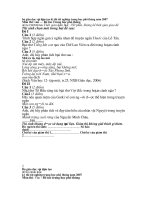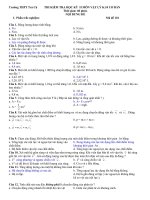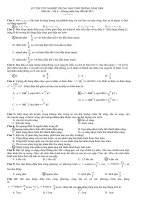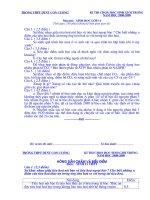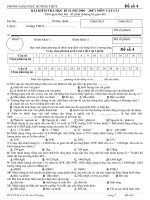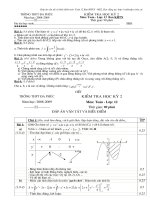Đề thi và đáp án CMO năm 2019
Bạn đang xem bản rút gọn của tài liệu. Xem và tải ngay bản đầy đủ của tài liệu tại đây (622.17 KB, 9 trang )
<span class='text_page_counter'>(1)</span><div class='page_container' data-page=1>
Official Solutions
1. Amy has drawn three points in a plane, A, B, and C, such that AB = BC = CA = 6. Amy is
allowed to draw a new point if it is the circumcenter of a triangle whose vertices she has already
drawn. For example, she can draw the circumcenterO of triangleABC, and then afterwards she can
draw the circumcenter of triangleABO.
(a) Prove that Amy can eventually draw a point whose distance from a previously drawn point is
greater than 7.
(b) Prove that Amy can eventually draw a point whose distance from a previously drawn point is
greater than 2019.
(Recall that the circumcenter of a triangle is the center of the circle that passes through its three
vertices.)
Solution.
(a) Given triangle 4ABC, Amy can draw the following
points:
•O is the circumcenter of4ABC
•A1 is the circumcenter of4BOC
•A2 is the circumcenter of4OBA1
•A3 is the circumcenter of4BA2A1
We claim that AA3 > 7. We present two ways to prove
this claim.
First Method: By symmetry of the equilateral triangle
4ABC, we have ∠AOB = ∠BOC = ∠COA = 120◦.
Since OB =OC and A1B =A1O =A1C, we deduce that
4A1OB ∼=4A1OC, and hence∠BOA1=∠COA1= 60◦.
Therefore, since 4A1OB is isosceles, it must be
equi-lateral. As we found for our original triangle, we find
∠BA2A1= 120◦, and so∠A2BA1 =∠A2A1B = 30◦ (since
T
T
T
T
T
T
T
T
T
T
T
T
T
T
"
"
"
"
"
"
"
""
b
b
b
b
b
b
b
b
b
b
b
b
b
b
b
b
bb
T
T
T
T
T
T
T
T
T
T
s s
s
s
s
s s
B C
A
O
A1
A2
A3
</div>
<span class='text_page_counter'>(2)</span><div class='page_container' data-page=2>
A2B =A2A1). Also we see that∠OBA2 = 30◦ =∠OBC, which shows that A2 lies on the segment
BC.
Applying the Law of Sines to 4BOC, we obtain
OC = BCsin(∠OBC)
sin(∠BOC) =
6(1/2)
√
3/2 = 2
√
3.
By symmetry, we see that (i) OA1 is the bisector of ∠BOC and the perpendicular bisector ofBC,
and (ii) the three pointsA,O, andA1 are collinear. Therefore A1A=A1O+OA= 2OA= 4
√
3.
The same argument that we used to show 4A1OB is equilateral with side AC/
√
3 shows that
4A3A2A1 is equilateral with sideOB/
√
3 = 2. Thus∠A3A1O=∠OA1B+∠A3A1A2−∠A2A1B =
60◦+ 60◦−30◦ = 90◦. Hence we can apply the Pythagorean Theorem:
A3A =
p
(A3A1)2+ (A1A)2 =
q
22<sub>+ (4</sub>√<sub>3)</sub>2 <sub>=</sub> √<sub>52</sub> <sub>></sub> √<sub>49 = 7.</sub>
Second Method: (An alternative to writing the justifications of the constructions in the First Method
is to use analytic geometry. Once the following coordinates are found using the kind of reasoning in
the First Method or by other means, the writeup can justify them succinctly by computing distances.)
Label (0,0) asB, (6,0) asC, and (3,√3) asA. Then we haveAB=BC =CA= 6.
The circumcenterO of 4ABC is (3,√3); this can be verified by observingOA=OB =OC= 2√3.
Next, the point A1 = (3,−
√
3) satisfies A1O = A1B = A1C = 2
√
3, so A1 is the circumcenter of
4BOC.
The pointA2= (2,0) satisfies A2O=A2B =A2A1= 2, so this is the circumcenter of 4OBA1.
And the point A3 = (1,−
√
3) satisfies A3B = A3A2 = A3A1 = 2, so this is the circumcenter of
4BA2A1.
Finally, we computeA3A =
√
52 > √49 = 7, and part (a) is proved.
(b) In part (a), using either method we find thatOA3 = 4>2
√
3 =OA. By rotating the construction
of part (a) by±120◦ about O, Amy can constructB3 andC3 such that4A3B3C3 is equilateral with
circumcenter O and circumradius 4, which is strictly bigger than the circumradius 2√3 of 4ABC.
Amy can repeat this process starting from 4A3B3C3. After n iterations of the process, Amy will
have drawn the vertices of an equilateral triangle whose circumradius is 2√3 ( 4
2√3)
n<sub>, which is bigger</sub>
than 2019 whennis sufficiently large.
</div>
<span class='text_page_counter'>(3)</span><div class='page_container' data-page=3>
2. Let a and b be positive integers such that a+b3 is divisible by a2 + 3ab+ 3b2 −1. Prove that
a2+ 3ab+ 3b2−1 is divisible by the cube of an integer greater than 1.
Solution.
Let Z = a2 + 3ab+ 3b2 −1. By assumption, there is a positive integer c such that cZ = a+b3.
Noticing the resemblance between the first three terms of Z and those of the expansion of (a+b)3,
we are led to
(a+b)3 = a(a2+ 3ab+ 3b2) +b3 = a(Z+ 1) +b3 = aZ+a+b3 = aZ+cZ .
ThusZ divides (a+b)3.
Let the prime factorization ofa+bbepe1
1 p
e2
2 · · ·p
ek
k and letZ =p
f1
1 p
f2
2 · · ·p
fk
k , wherefi ≤3eifor each
isinceZ divides (a+b)3. IfZ is not divisible by a perfect cube greater than one, then 0≤fi ≤2 and
hencefi≤2eifor eachi. This implies thatZdivides (a+b)2. However, (a+b)2 < a2+3ab+3b2−1 =Z
sincea, b≥1, which is a contradiction. ThusZ must be divisible by a perfect cube greater than one.
</div>
<span class='text_page_counter'>(4)</span><div class='page_container' data-page=4>
3. Let m and n be positive integers. A 2m×2n grid of squares is coloured in the usual chessboard
fashion. Find the number of ways of placingmncounters on the white squares, at most one counter
per square, so that no two counters are on white squares that are diagonally adjacent. An example
of a way to place the counters whenm= 2 and n= 3 is shown below.
Solution.
Divide the chessboard intomn 2×2 squares.
Each 2×2 square can contain at most one counter. Since we want to placemn counters, each 2×2
square must contain exactly one counter.
Assume that the lower-right corner of the 2m×2n chessboard is white, so in each 2×2 square, the
upper-left and lower-right squares are white. Call a 2×2 square UL if the counter it contains is
on the upper-left white square, and call it LR if the counter it contains is on the lower-right white
square.
Suppose some 2×2 square is UL. Then the 2×2 square above it (if it exists) must also be UL, and
the 2×2 square to the left of it (if it exists) must also be UL.
</div>
<span class='text_page_counter'>(5)</span><div class='page_container' data-page=5>
Similarly, if some 2×2 square is LR, then the 2×2 square below it (if it exists) must also be LR,
and the 2×2 square to the right of it (if it exists) must also be LR.
Then the collection of UL 2×2 squares form a region that is top-justified and left-justified, and
the collection of LR 2×2 squares form a region that is bottom-justified and right-justified. This
means that the boundary between the two regions forms a path between the lower-left corner and
upper-right corner of the 2m×2nchessboard.
Conversely, any path from the lower-left corner to the upper-right corner, where each step consists of
two units, can serve as the boundary of the UL squares and LR squares. Thus, the number of ways
of placing the counters is equal to the number of paths, which is m<sub>m</sub>+n
</div>
<span class='text_page_counter'>(6)</span><div class='page_container' data-page=6>
4. Letnbe an integer greater than 1, and leta0, a1, . . . , anbe real numbers with a1 =an−1 = 0. Prove
that for any real number k,
|a0| − |an| ≤
n−2
X
i=0
|ai−kai+1−ai+2|.
First Solution.
LetQ(x) =x2−kx−1 and letP(x) =a0+a1x+· · ·+anxn. Note that the product of the two roots
of Q(x) is−1 and thus one of the two roots has magnitude at most 1. Let zbe this root. Now note
that sincea1 =an−1 = 0, we have that
0 =Q(z)P(z) =−a0−ka0z+
n−2
X
i=0
(ai−kai+1−ai+2)zi+2−kanzn+1+anzn+2
=a0(−1−kz) +
n−2
X
i=0
(ai−kai+1−ai+2)zi+2+anzn(z2−kz)
=−a0z2+
n−2
X
i=0
(ai−kai+1−ai+2)zi+2+anzn
where the third equality follows sincez2−kz−1 = 0. The triangle inequality now implies
|a0| · |z|2≤ |an| · |z|n+
n−2
X
i=0
|ai−kai+1−ai+2| · |z|i+2
≤ |an| · |z|2+
n−2
X
i=0
|ai−kai+1−ai+2| · |z|2
since|z| ≤1 and n≥2. Since z6= 0, the inequality is obtained on dividing by |z|2<sub>.</sub>
Second Solution.
Letk be a real number. Put
R =
√
k2<sub>+ 4</sub> <sub>if</sub><sub>k</sub><sub>≥</sub><sub>0,</sub>
−√k2<sub>+ 4</sub> <sub>if</sub><sub>k <</sub><sub>0.</sub>
Define the polynomial
S(x) = x2+Rx+ 1.
The roots of S are
b = −R−k
2 and c =
−R+k
2 .
Then we have
b−c = −k, bc = 1, and |c| ≤1
(the inequality follows from bc= 1 and |c| ≤ |b|).
</div>
<span class='text_page_counter'>(7)</span><div class='page_container' data-page=7>
Putdi =ai+b ai+1 fori= 0,1, . . . , n−1. Then, fori= 0,1, . . . , n−2, we have
di−c di+1 = ai+ (b−c)ai+1−bc ai+2
= ai−k ai+1−ai+2.
Therefore
n−2
X
i=0
|ai−k ai+1−ai+2| =
n−2
X
i=0
|di−c di+1|
≥
n−2
X
i=0
(|di| − |c| |di+1|)
= |d0| + (1− |c|)
n−2
X
i=1
|di| − |c| |dn−1|
≥ |d0| − |c| |dn−1|
= |a0+b a1| − |c| |an−1+b an|
= |a0| − |bc| |an|
</div>
<span class='text_page_counter'>(8)</span><div class='page_container' data-page=8>
5. David and Jacob are playing a game of connecting n≥3 points drawn in a plane. No three of the
points are collinear. On each player’s turn, he chooses two points to connect by a new line segment.
The first player to complete a cycle consisting of an odd number of line segments loses the game.
(Both endpoints of each line segment in the cycle must be among the n given points, not points
which arise later as intersections of segments.) Assuming David goes first, determine all nfor which
he has a winning strategy.
Solution:
Answer: David has a winning strategy if and only if n≡2 (mod 4).
Call a moveillegal if it would cause an odd cycle to be formed for the first time. First we show that
if nis odd, then any strategy where Jacob picks a legal move if one is available to him causes him
to win. Assume for contradiction that Jacob at some point has no legal moves remaining. Since the
graph representing the game state has no odd cycle, it must be bipartite. Let a and b be the sizes
of the two sets in the bipartition of the graph. If there is some edge not already added between the
two sets, adding this edge would be a legal move for Jacob. Therefore the graph must be a complete
bipartite graph with all of its abedges present. However, since a+b=n which is odd, one of aor
b must be even and thus the graph contains an even number of edges. Moreover, since it is Jacob’s
turn, the graph must contain an odd number of edges, which is a contradiction. Therefore Jacob has
a winning strategy for all odd n.
Now consider the case wherenis even. Call a graphgood if the set of vertices of degree at least 1 are
in a perfect matching (a set of non-adjacent edges that includes every vertex of the graph). The key
observation is that either player has a strategy to preserve that the graph is good while increasing the
number of vertices of degree at least 1. More precisely, if the graph was good at the end of a player’s
previous turn and there are fewer thannvertices of degree at least 1, then at the end of his current
turn he can always ensure that: (1) the graph is good and (2) there are at least two more vertices of
degree 1 since the end of his previous turn. Let A be the set of vertices of degree at least 1 at the
end of the player’s previous turn and B be the set of remaining vertices where |B| >0. Since the
vertices ofA have a perfect matching, |A|is even, and sincen is even, so is |B|. If the other player
adds an edge between two vertices ofA, add an edge between two vertices of B. If the other player
adds an edge between two vertices of B, add an edge between one of those vertices an a vertex of A
(but on the first round, whenA is empty, respond by adding an edge between two other vertices of
B). If the other player adds an edge between a vertex inAand a vertex in B, then since|B|is even,
there must be another vertex of B. Connect these two vertices in B with an edge. None of these
moves can form a cycle and thus are legal. Furthermore, all of them achieve (1) and (2), proving the
claim.
We now show that David has a winning strategy if n ≡ 2 (mod 4). Since the graph begins empty
and therefore good, David has a strategy of legal moves to ensure that the graph contains a perfect
matching after no more than nmoves. After this, let David implement any strategy where he picks
a legal move if one is available to him. Assume for contradiction that there is a turn where David
has no legal moves. This graph must be a complete bipartite graph containing a perfect matching.
If one of the sets in the bipartition has size greater than n/2, it must contain two vertices matched
in the perfect matching, which is impossible. Therefore there aren/2 vertices in each part andn2/4
edges have been added in total, which is an odd number. This contradicts the fact that it is David’s
turn, and proves the result forn≡2 (mod 4).
</div>
<span class='text_page_counter'>(9)</span><div class='page_container' data-page=9></div>
<!--links-->
